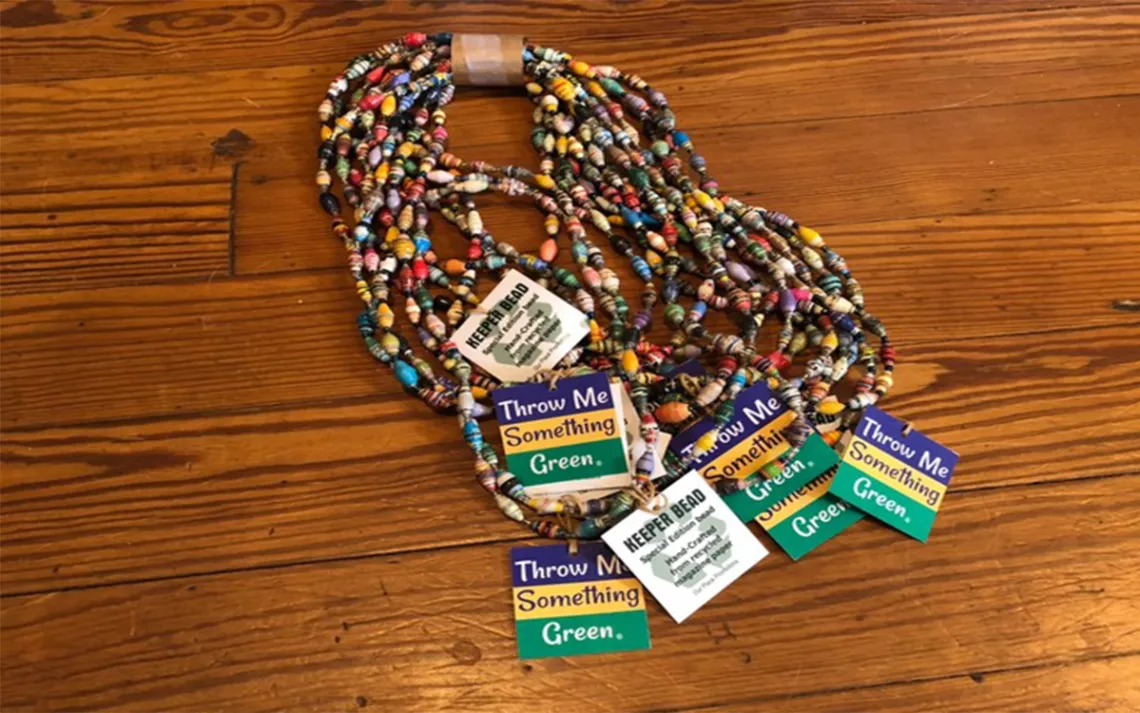Can Sustainable Mardi Gras Beads Become a Thing?
Gary Zoller is on a mission to transform Mardi Gras, one necklace at a time

Photo courtesy of Gary Zoller
In January, the city of New Orleans made a shocking announcement. Cleaning crews had extracted 93,000 pounds of plastic Mardi Gras beads from the gutters on a two-mile stretch of St. Charles Street, the main Mardi Gras parade route. The beads had accumulated there after being flung to revelers from passing floats.
The news did not surprise Gary Zoller. His family has proudly celebrated Mardi Gras for decades—in 1968, his uncle was the first Jewish founder of a krewe. “Back then, Mardi Gras was more about the procession and not so much about the stuff,” he says. “I grew up with the sense that what you caught at the parade was about quality not quantity.” He recalls that the best keeper throws, as they are called, were glass beads.
But since then, the culture has shifted. Now, he says, krewes are judged by how much is flying off their float. “A bag of those plastic beads probably weighs about 25 pounds, and a float probably has six, seven, or eight of those bags. Some people throw a whole bag at a time.” Dozens of parades are held over a three-week period leading up to the final celebration in early March. During this time, beads pile up in garbage cans and on the street.
Even if paradegoers managed to collect them all and take them home, the beads would still be problematic. For one thing, they are highly toxic. “You come home from riding a float,” Zoller says, “and you smell. There’s toxic stuff on your hands and you’re touching your face, and you think, what am I doing to myself?”
In a 2013 study by the Ecology Center, about two-thirds of the beads tested exceeded the federal safety limit for lead in children’s products. They also contained other toxic substances, including cadmium, phthalate plasticizers, mercury, arsenic, and flame-retardants, all of which have been linked to health problems such as cancer, birth defects, and learning disabilities. The beads are bad for partygoers but even worse for the workers who make them in China, where they are manufactured. And, they inevitably make their way into waterways, where they pollute the environment and enter the food chain.
Companies marketing sustainable alternatives to plastic beads do exist, but none have made significant inroads into the prevailing disposable-bead culture that goes hand in hand with Mardi Gras. Some nonprofits try to make a dent by collecting used beads, washing them, and redistributing them, but as Zoller points out, “they’re the same toxic beads.”
About two years ago, Zoller decided he'd had enough of the plastic beads. Through his company, Our Place Promotions, he started marketing necklaces made out of beads handspun with magazine paper by communities of women in Africa. Throw Me Something Green was born. The beads are covered with a nontoxic, water-based coating. He and his employees meet with krewes and throw bead parties, and he is a regular guest on a local radio program where he is known as “the bead guy.” “I hand them out to everyone I meet,” he says. Last year, the company sold about a thousand necklaces. This year, they more than doubled that.
It’s a small operation, but Zoller likes to think big. He dreams of one day opening a factory in New Orleans in order to manufacture the paper beads locally. He acknowledges that the beads will never be as cheap as plastic ones imported from China, but he believes that with critical mass, the cost would come down and the product could be competitive.
The idea of locally made, sustainable beads taking over Mardi Gras might seem like a stretch, but Zoller is quick to point out that all the other aspects of Mardi Gras floats are already made locally. “It’s a big industry of artisans, painters, electricians, and carpenters; really it’s just the beads that are outsourced.”
For Zoller, Throw Me Something Green is as much about shifting the city’s general mentality of waste as it is about selling beads. For example, one traditional metric for gauging the success of Mardi Gras is how much trash it generates. To be sure, trash is a useful indicator of how many people attend the celebrations, but why not, Zoller wonders, use some other metric to measure success, like how little trash the event generates, or how environmentally sustainable it is.
Ultimately, Zoller would like to work in tandem with a citywide initiative to go green for Mardi Gras. What if floats were rated on how eco they were? What if there were an environmental scorecard for parades? Zoller believes if city officials got on board, a sea change could be possible. This year, as he rode with his krewe, he only threw Throw Me Something Green beads. “I want to be part of the solution, not the problem,” he says.
This article has been updated since publication.
 The Magazine of The Sierra Club
The Magazine of The Sierra Club